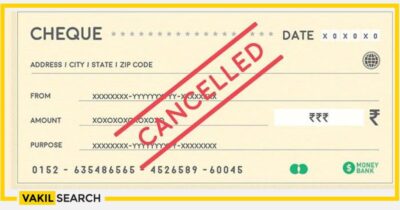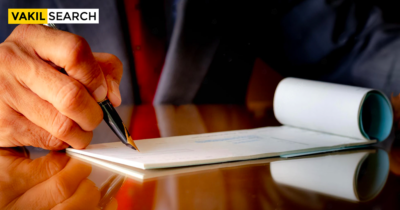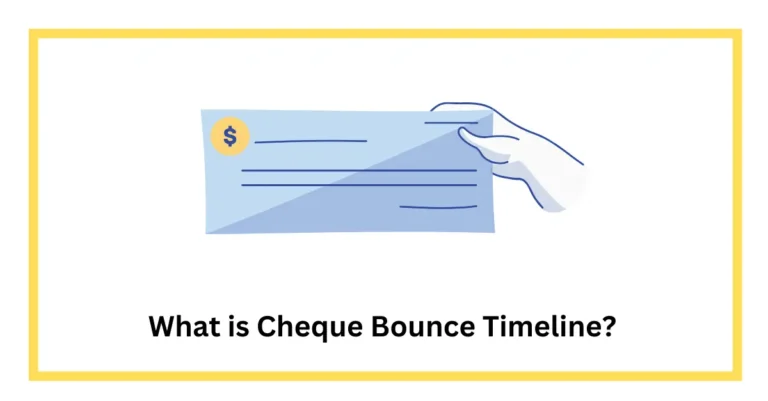Cheque bounce rates pose a cause of concern, especially when payments via cheques get disapproved for various reasons. This article will serve you as a complete guide on how you can tackle such tricky situations that require legal expertise.
The Negotiable Instruments law (1881) indicates an event of cheque bounce as a punishable offence under Section 138. The offender is subjected to monetary compensation that equals almost twice the value of the faulty cheque amount. At times, the person involved in the case can be put behind bars along with a fine; imprisonment can last up to 2 years. In this blog we can have a detailed section on “What to Do When a Cheque Bounces?”
What is the Meaning of a Cheque Bounce?
When the payee offers a cheque to any commercial bank to complete a payment, while the cheque gets cancelled due to declination from the bank’s end displaying a memo of inadequate funds, the cheque is identified as a bounced cheque.
Many reasons can be responsible for a cheque bounce event. Specifically, when a cheque bounce occurs because of an inadequate sum in the cheque drawer’s bank account, this reciprocates an offence per the Negotiable Instruments law.
The bank should decline the presented cheque and cancel the payment process. The processing bank will issue a supporting invoice or return memo declaring the condition of payment failure; in this case, it is the insufficient bank balance.
The cheque’s payee now has the right to issue a legal cheque bounce notice demanding the drawer to furnish the full amount. We have to Pay the Cheque Bounce Charges if there are any applicable.
Cheque Bounce Rates
The detailed cheque bounce rates for popular banks across India have been shared with you:
| Bank name | Cheque bounce rates |
| State Bank of India |
|
| Bank of Baroda | For each cheque that faces outward return and is drawn on the Bank of Baroda,
If a cheque bounce happens due to technical reasons, ₹250 is charged irrespective of the amount. |
| Axis Bank | ₹500 is the fixed amount issued as a fine for cheque returns furnished at the bank’s home branch. |
| HDFC Bank |
|
| ICICI Bank |
|
What Actions Are Justifiable After a Business Cheque Bounces?
Many business cheques are reported to get disapproved by the processing bank owing to technical problems like a signature mismatch, overwriting, or dissimilarity between amounts stated in words and figures. Physically damaged cheques are also discarded. The payee at first instructs the drawer to reissue a new cheque by correcting the mistakes.
In some cases, the payee desires to opt for other modes of payment as well. If the defaulter disagrees with terms set by the payee, the latter party has the right to seek the assistance of legal executives.
Under Section 138, a payee can issue a Cheque Bounce Notice against the drawer as stated by the Negotiable Instruments law. This rule is applicable when the payment stops due to an insufficient account balance. The payee needs to request the drawer to resubmit the cheque if the reason behind the disruption is found to be a technical problem and not any underlying financial issue.
Processes that Take Place After Issuing a Bounce Notice
The payee can proceed to execute civil action if no remittance is arranged within 15 days of generating a cheque bounce notice. A dispute against the drawer must occur under Section 138 (Negotiable Instruments law).
In the following section, we have discussed the Magistrate’s jurisdiction that is necessary for issuing a cheque bounce suit. Complaint filing by the payee has to take place in front of the Magistrate in a place chosen from the following list of alternatives:
- The place where the cheque had been drawn in the first place
- Bank where the drawer presented the cheque for payment
- The address where the payment should have reached
- The place where the cheque got dishonoured
- Where the payee served the demand notice
Metropolitan Magistrate should be present at the moment of filing a cheque bounce complaint provided the cheque dishonour takes place in a metropolitan location. The judicial Magistrate assumes an equivalent role when a cheque bounce occurs involving a different city.
The ideal reply generated against a legal cheque bounce notice does not abide by a prescribed format. However, the following topics have to be addressed with due sincerity:
- The reply should be directed toward the legal representative of the payee.
- Facts have to be clearly stated, this includes the date of problem, cheque return invoice, etc.
- The allegation must not be admitted as mentioned in the notice issued by the payee
- Must include a description of the transaction, name, address details, etc.
- A summary to support your defence against all the allegations
Conclusion
Attorneys need to be hired in cases involving a draft with bounce. This problem involving dishonoured cheques is seen as a criminal offence in India. To learn about such topics, you may read similar articles that Vakilsearch publishes.
Also Read,









